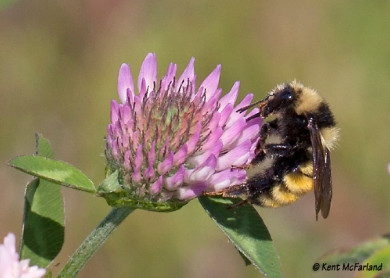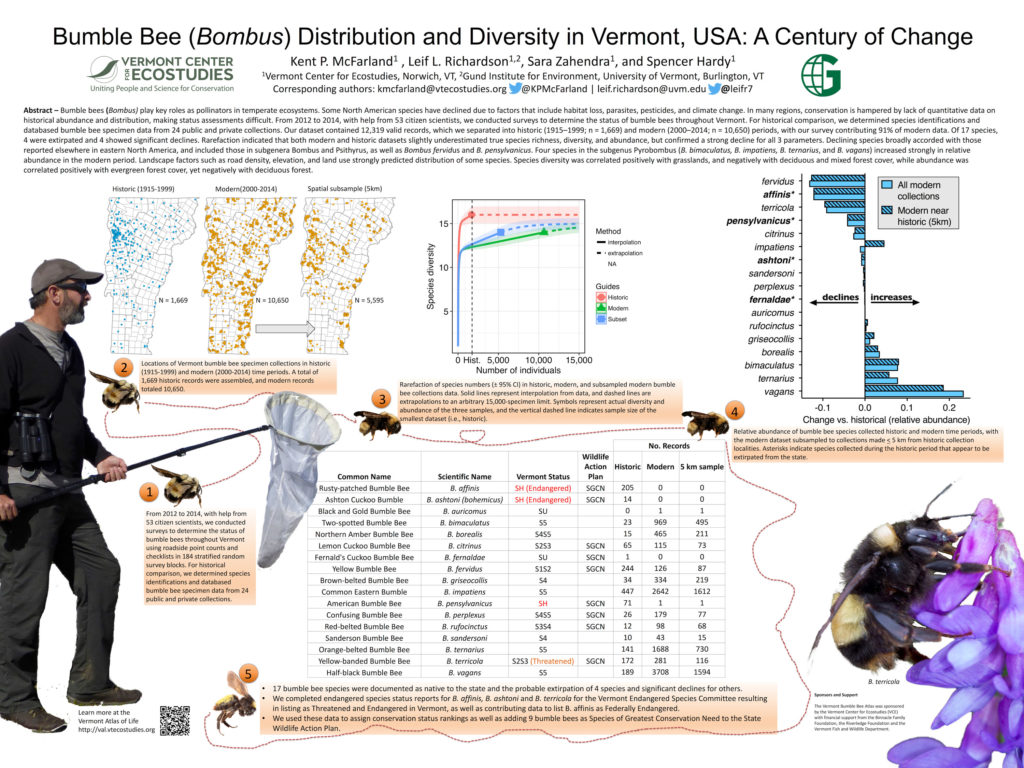About half of Vermont’s bumble bee species, which are vital crop pollinators, have either vanished or are in serious decline.
From 2012-2014, with help from 53 citizen scientists, we conducted surveys to determine the status of bumble bees throughout Vermont. For historical comparison, we determined species identifications and databased bumble bee specimen data from 24 public and private collections. We amassed 10,196 bumble bee records (5,105 in 2012 and 5,091 in 2013) comprised of 12 species from all 14 Vermont counties. To provide comparative information for current survey results, we obtained historical data from 24 public and private collections. We assembled 2,418 bumble bee records representing 17 species from all 14 Vermont counties. We sorted and identified the entire bumble bee collection in the UVM Zadock Thompson Invertebrates Collection (1,356 specimens). Most specimens were collected by entomology students over the past ~40 years in Chittenden County, representing an important record of bumble bee populations in the region.
Of the 17 bumble bee species known to have historically occurred in Vermont, we were unable to locate Rusty-patched Bumble Bee (Bombus affinis) (204 historic records), American Bumble Bee (B. pensylvanicus) (72 historic records), Ashton’s Cuckoo Bumble Bee (B. ashtoni) (11 historic records),Fernald Cuckoo Bumble Bee (B. fernaldae) (1 historic record, 6 Aug 1936, Island Pond, VT), or Black and Gold Bumble Bee (B. auricomus) (1 historic record, 31 May 2006, Button Bay State Park, VT).
In the late 1990s, biologists noticed a decline in the abundance and distribution of bumble bee species worldwide. In the Northeast, there appeared to be a sudden, range-wide population decline of several species. For example, Rusty-patched Bumble Bee, a pollinator of wildflowers, cranberries, and other crops, was commonly collected by UVM students as recently as the early 1980s. Not a single specimen has been found in Vermont since 1999. One of the formerly most common bumble bees of fields, farms, and gardens has disappeared from our state in the span of a decade or less. An obligate parasite of Rusty-patched Bumble Bee and Yellow-banded Bumble Bee (B. terricola), Ashton’s Cuckoo Bumble Bee appears to have followed its host’s trend. We completed endangered species status reports for each of these species to the Vermont Endangered Species Committee resulting in listing as state threatened and endangered.
Despite extensive surveys in areas that formerly held American Bumble Bees, it appears to be extirpated from the state. The last known record was reported in 2000. Seven species of bumble bees appear to be of conservation concern. Further analysis is needed for several others. Although, some species appear to have possibly increased – Half-black Bumble Bee (B. bimaculatus) and the Northern Amber Bumble Bee (B. borealis) all appear to have become more widespread and abundant compared to historic collections.
Additionally, the survey documented a more northern range for Eastern Carpenter Bee (Xylocopa virginica) in Vermont than was previously known. We recorded 27 in 2012 and 17 in 2013 for a total of 44 records. The species was found at 27 sites ranging from the Massachusetts border north to Hartland and just south of Bethel in the Connecticut River valley and as far north as Cornwell west of the Green Mountains.
Publications
- Richardson, L. L., K.P. McFarland, S. Zahendra, and S. Hardy. 2018. Bumble bee (Bombus) distribution and diversity in Vermont, USA: a century of change. Journal of Insect Conservation. https://doi.org/10.1007/s10841-018-0113-5. (PDF)
- McFarland, K.P., L.L. Richardson, and S. Zahendra. 2016. Vermont Bumble Bee Survey: Faunal Changes in Vermont, 1900-2014. Final Report to the Vermont Fish and Wildlife Department. Vermont Center for Ecostudies. 32pp. (PDF)
Vermont Threatened and Endangered Species Status Assessments
- McFarland, Kent and Leif Richardson. 2020. American Bumblebee (Bombus pensylvanicus): Report to the Vermont Endangered Species Committee. DOI: 10.13140/RG.2.2.10826.29125
- McFarland, Kent, Leif Richardson, and Sara Zahendra. 2014. Rusty-patched Bumble Bee (Bombus affinis): Report to the Vermont Endangered Species Committee. DOI: 10.13140/RG.2.1.1305.9289 (PDF)
- McFarland, Kent, Leif Richardson, and Sara Zahendra. 2014. Yellow-banded Bumblebee (Bombus terricola): Report to the Vermont Endangered Species Committee. DOI: 10.13140/RG.2.1.1764.0405.1844 (PDF)
- McFarland, Kent, Leif Richardson, and Sara Zahendra. 2014. Ashton’s Cuckoo Bumblebee (Bombus ashtoni): A report to the Vermont Endangered Species Committee. DOI: 10.13140/RG.2.1.2026.1844 (PDF)








